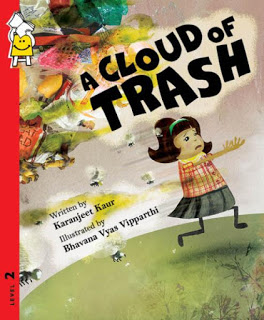
Today’s story comes from Seema Wahi Mukherjee who conducted a storytelling session in Gurgaon. Seema describes herself as a versatile person who combines her knowledge, experience and interests to create engaging interactions with children as well as adults. Passionate about creating learning environments which encourage questioning, uncovering how children think and what they believe in, challenging mind sets, suggesting alternative ways to view things; provide an opportunity to express themselves through various mediums like painting, sketching, making puppets, puppetry, drama, role plays, writing & reviewing stories, making story books/ boards.
Seema writes about her storytelling session …
It was a proud moment to be one of Pratham Books champions and conduct the workshop at my premises. Pratham Books is a great inspiration as it has made all efforts to fulfill its dream of “a book in every child’s hand”. Pratham Books’ innovative story cards which sell for Rs.2/- at all small shops in many parts of the country exemplifies the saying, “Where there is a will, there is a way.”
Here is a brief about the pre-session preparation, story session and post session activities.
Preparations for the story session- Once the books were received and the venue was decided, the next step was to publicise the session. I met kids in the park and informed them of the event. I also taped posters to generate interest in each of the 6 towers in my apartment complex. Many of the children had reservations about listening to a snake’s story. I was surpised to realise the discomfort of adults as well as children when you say the word “snake”- somehow the general feeling snakes evoke is of revulsion and fear! Still, I hoped that atleast ten children would attend. There was a determination to make the story telling experience as pleasant as possible.
Reading the book and planning the session– The book provided a lot of information about the life of a snake. It was important to remember some of the facts which would enrich knowledge of children. Remaining task was to tell the story in an interesting manner. I thought of two options:
- showing the pictures and telling the story in my words
OR
- not using the book and narrating the story sequentially from the time of Kaala’s birth as opposed to the order in which it is told in the book. Color print-outs of the pictures sent by Pratham Books was taken. These were laminated and then cut out to make stick puppets.
Finally 17th december arrived. The kids started arriving. There were twenty five children in all- youngest one being 2 and a half and oldest around thirteen years. One couple got their young two plus year old kids and sat through the session. One of the children, Mahek came back straight from school and came in for the session. She did not even change out of her school uniform.
An interesting song “Anaconda song” on the YouTube played in the background as the children arrived. A song on Cobra would have been preferable but I could not find any animation song on cobra. The song was viewed with interest.
Two snakes on my cheek – one for Kaala and the other for Leela- did generate some talk about how they would be not comfortable with snakes on their cheeks.
The fact that they were hesitant and apprehensive about listening to a snakes’s story was a bit disconcerting and I did wonder how they would receive the story. The positive thing was that despite their apprehension they still came to attend the session.
Warming up session: We formed a circle and I asked children”how does a snake move?” The young children especially boys immediately lay down on the mat and started slithering on the floor. The older girls were quite stiff and once the younger ones had their share of fun, I asked the older ones to follow my words and gestures. “As we grow older, we feel shy and may not be as spontaneously as younger children.Sometimes we “behave” more mature because we have to and sometimes because others expect us too. Today, lets just pull this shyness out of our hearts and throw it out of the window, so that we can be as open and spontaneous as we used to be earlier”. The chidlren repeated the last line “Today ….earlier.” given above. This was accompanied by a gesture of pulling shyness out and throwing it away accompanied this. And it did work! We did this thrice and by the third cycle,the girls seemed more relaxed and were smiling.


Once the children warmed up and appeared comfortable, they sat down for the session.
Before starting the story, I told them the reason why the author wrote the story. And a quiz to understand their pre knowldege of snakes was conducted.
In the beginning of the story, the children were astonished with the fact that snakes can shed their skin. Then the story plunged them in action packed drama of the fight with python, the sleep in villager’s bathroom, reaction of villagers and then the snake being placed in a bag and left far away from home. I loved the expression on their faces. The younger group was very keen to see the picture of Kaala’s poop. They insisted on viewing it closely.
The next part of the story about the cobra’s birth was intriguing as well. Why the mother leaves the snakes as they hatch and why all the snakes go different ways did raise many questions, specially with young children.
This was followed by Kaala’s desire to reach back to reclaim his home and reunite with Leela was amusing for the older kids. The girls specially giggled at the love story of Kaala and Leela. They were collectively happy when Kaala finally reached home, defeated Ketu and found Leela had all elements of a popular movie. It almost make snake seem human.
An interesting observation was that though children could identify with Kaala at times, they completely identified themselves with human beings when there was any interaction between Kaala and the humans.
A question was asked:
Do you think human beings are strange creatures?
Most children disagreed and felt human being were not strange.The agrument that response of all animals to Kaala was same- it was of fear. It was the response of human beings, that was different in different situations. The older children found the human behaviour, though inconsistent, as normal.
After the story, there was a recap with children participating and sequencing the events. The children seemed much more comfortable with snakes after the session. They were eager to move to the craft activity and make their own snakes. Many of them asked me if I could make snake tatoos on their arms ( still not on the cheeks) which was a positive step. By the end of the session, each child had made a snake mobile for himself/ herself and got a snake made on his/ her arm.
Some mothers who came to collect their chidlren stayed back to participate in the craft activity. One of them was sporting enough to get a snake made on her cheek.
The children a) learnt to view snake in a different light, b) were able to move past their shyness as well as fear, c) learnt some facts about snakes, d) sequenced the events in the story, e) made snake mobiles, f) expressed their creativity by making different designs on their snake mobiles. I expressed my thanks to them for taking out time and participating in the session. They went back happy and excited. The feedback of the children as well as their mothers is that they would like more of such sessions.On the whole, it was a successful session.
**********
Thank you Seema for spreading the joy of reading!
Click here to read the stories sent in by all the Pratham Books Champions.
Note : If any of you want to be a Pratham Books Champion and join us on our journey of getting ‘a book in every child’s hand’, write to us at web(at)prathambooks(dot)org.

 Today’s story comes from Seema Wahi Mukherjee who conducted a storytelling session in Gurgaon. Seema describes herself as a versatile person who combines her knowledge, experience and interests to create engaging interactions with children as well as adults. Passionate about creating learning environments which encourage questioning, uncovering how children think and what they believe in, challenging mind sets, suggesting alternative ways to view things; provide an opportunity to express themselves through various mediums like painting, sketching, making puppets, puppetry, drama, role plays, writing & reviewing stories, making story books/ boards.
Today’s story comes from Seema Wahi Mukherjee who conducted a storytelling session in Gurgaon. Seema describes herself as a versatile person who combines her knowledge, experience and interests to create engaging interactions with children as well as adults. Passionate about creating learning environments which encourage questioning, uncovering how children think and what they believe in, challenging mind sets, suggesting alternative ways to view things; provide an opportunity to express themselves through various mediums like painting, sketching, making puppets, puppetry, drama, role plays, writing & reviewing stories, making story books/ boards. 

















